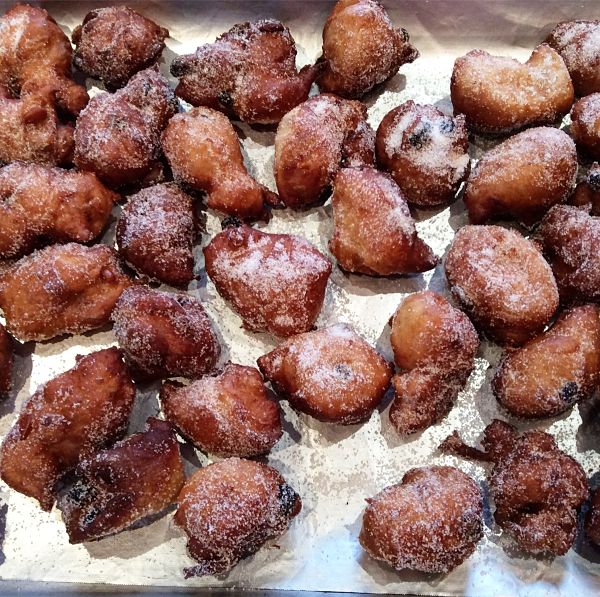
Frittelle is the generic name for “fritters”, however for most Italians frittelle (pronounced frihttehlleh) is synonymous with Carnival. Frittelle are deep fried pastries, generally made with an enriched bread dough or a choux dough, often containing sultanas, citrus zest and pine nuts. When well made, they are light and hollow inside, not at all doughy. They can be either plain or filled with creme patisserie, which is perhaps gilding the lily. In Venice there is a cult for Carnival fritters, no surprisingly perhaps, considering how deeply felt Carnival is up there – it is an important part of the city’s history and cultural identity. Personally, I prefer the other, plainer Carnival pastries, chiacchiere, but I would never say no to a warm frittella (which is the singular for the plural frittellE)
Frittelle veneziane – Venetian Carnival fritters
Adapted from the Italian pastry chef Luigi Biasetto
Enough for 6 to 8 people
300 g bread flour
1 teaspoon instant dry yeast (3 g)
1 scant teaspoon fine sea salt (5 g)
40 g granulated sugar
grated zest of half a lemon
grated zest of half an orange
50 g soft butter
150 ml milk
2 eggs, well beaten with 1 teaspoon of vanilla extract
75 g pinenuts, toasted
75 g sultanas, soaked in rum and squeezed dry
extra sugar to coat the frittelle
Add the milk to the eggs.
Place the flour, yeast, salt, sugar, citrus zest and butter in the bowl of a mixer and mix to incorporate. Using the beater attachment, gradually add the egg-milk mix. Increase the speed to medium and beat until the batter becomes an elastic, smooth dough. This will take some time, from 10 to 15 minutes. The final dough will be smooth but still soft and tacky (add a little flour by the teaspoon, if the dough is really too slack).
Let it rest covered for 15 minutes. Add the pine nuts and sultanas and incorporate them. Form the dough into a ball, place it in an oiled bowl, cover it with cling film and let it proof until tripled in size, at room temperature. If your kitchen is cold, place the dough in a switched-off oven where you have already placed a mug of boil. Stretch and fold the dough a couple of times during the proofing time, to give it strength. This will make for lighter frittelle later on.
You can now fry the frittelle. Bring a pan filled with vegetable oil to 175 Celsius/347 F. Meanwhile turn the dough onto a lightly oiled tray and keep it by the cooking pot.
Spoon generous teaspoon-size portions of dough into the hot oil, without crowding the pan. Fry the frittelle, until deep golden, turning them and spooning some hot oil over them: I found it also helps if you push them down into the hot oil using a spider – this will make for more uniform frying. As you fry, make sure to remove from the oil the bits that may escape loose from the dough and that would end up burnt and make the oil bitter.
Remove the frittelle from the oil and lay them on a tray lined with a couple of layers of kitchen paper.
As soon as you can touch them, roll them in sugar. Eat them warm. They are at their best when freshly fried, but keep well for a few hours (in a very low oven, with the door ajar).
I have never had any of these Carnevale specialties! You make me very hungry!
I hope you are both well… we are having 4 days of rain in the desert. It delightful but I miss my sunshine!
LikeLike
ciao david…ah!… u must try these fritters…at least to fill the gap in your knowledge of Italian food: I love chiacchiere but frittelle are excellent too (think a lean brioche dough being deep fried 🙂 =
LikeLike
Now you’re really making me miss Venice!
LikeLike
Venetians are obsessed with frittelle or “frittoe” as they call them in dialect… well… here u go: try them!
LikeLike
What great fun learning all the traditional Shrove Tuesday dishes from around the world. The Italian version is on top of my to make list.
LikeLike
ciao Ron
my English half and my friends loved these fritters… I prefer the chiacchiere (see the previous posts), but they are undoubtedly good
LikeLike
Thank you for this recipe, I’m sending the link to this page to my UK guest in Venice, a girl very interested in cooking!
LikeLike
Giusto giusto mi fa comodo, grassie! Passo subito a mia carinissima ospite UK qui a Venezia in questi giorni 🙂
LikeLike
… cite’ vuoi che la tapina si metta a friggere nello stilosissimo appartamentino? 🙂 …
LikeLiked by 1 person
eh ma lei se le gusta a Venessia e poi, tornata a casetta sua, se le prepara. Una ragazza DELIZIOSA!!!
LikeLike